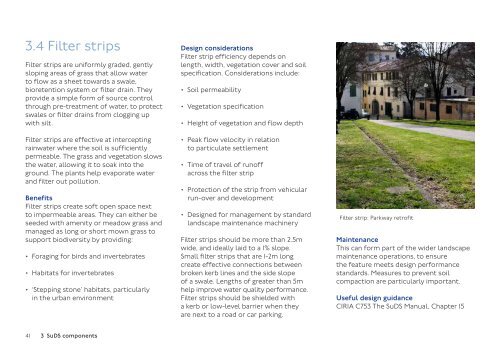SuDS in London - a guide
sustainable-urban-drainage-november-2016
sustainable-urban-drainage-november-2016
Create successful ePaper yourself
Turn your PDF publications into a flip-book with our unique Google optimized e-Paper software.
3.4 Filter strips<br />
Filter strips are uniformly graded, gently<br />
slop<strong>in</strong>g areas of grass that allow water<br />
to flow as a sheet towards a swale,<br />
bioretention system or filter dra<strong>in</strong>. They<br />
provide a simple form of source control<br />
through pre-treatment of water, to protect<br />
swales or filter dra<strong>in</strong>s from clogg<strong>in</strong>g up<br />
with silt.<br />
Filter strips are effective at <strong>in</strong>tercept<strong>in</strong>g<br />
ra<strong>in</strong>water where the soil is sufficiently<br />
permeable. The grass and vegetation slows<br />
the water, allow<strong>in</strong>g it to soak <strong>in</strong>to the<br />
ground. The plants help evaporate water<br />
and filter out pollution.<br />
Benefits<br />
Filter strips create soft open space next<br />
to impermeable areas. They can either be<br />
seeded with amenity or meadow grass and<br />
managed as long or short mown grass to<br />
support biodiversity by provid<strong>in</strong>g:<br />
• Forag<strong>in</strong>g for birds and <strong>in</strong>vertebrates<br />
• Habitats for <strong>in</strong>vertebrates<br />
• ‘Stepp<strong>in</strong>g stone’ habitats, particularly<br />
<strong>in</strong> the urban environment<br />
Design considerations<br />
Filter strip efficiency depends on<br />
length, width, vegetation cover and soil<br />
specification. Considerations <strong>in</strong>clude:<br />
• Soil permeability<br />
• Vegetation specification<br />
• Height of vegetation and flow depth<br />
• Peak flow velocity <strong>in</strong> relation<br />
to particulate settlement<br />
• Time of travel of runoff<br />
across the filter strip<br />
• Protection of the strip from vehicular<br />
run-over and development<br />
• Designed for management by standard<br />
landscape ma<strong>in</strong>tenance mach<strong>in</strong>ery<br />
Filter strips should be more than 2.5m<br />
wide, and ideally laid to a 1% slope.<br />
Small filter strips that are 1-2m long<br />
create effective connections between<br />
broken kerb l<strong>in</strong>es and the side slope<br />
of a swale. Lengths of greater than 5m<br />
help improve water quality performance.<br />
Filter strips should be shielded with<br />
a kerb or low-level barrier when they<br />
are next to a road or car park<strong>in</strong>g.<br />
Filter strip: Parkway retrofit<br />
Ma<strong>in</strong>tenance<br />
This can form part of the wider landscape<br />
ma<strong>in</strong>tenance operations, to ensure<br />
the feature meets design performance<br />
standards. Measures to prevent soil<br />
compaction are particularly important.<br />
Useful design guidance<br />
CIRIA C753 The <strong>SuDS</strong> Manual, Chapter 15<br />
41 3 <strong>SuDS</strong> components


